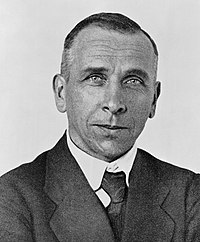
Back Alfred Wegener Afrikaans ألفريد فيغنر Arabic الفريد فيجنر ARZ Alfred Vegener Azerbaijani آلفرد وقنر AZB Альфрэд Лотар Вегенер Byelorussian Альфрэд Лётар Вэгенэр BE-X-OLD Алфред Вегенер Bulgarian আলফ্রেড ভেগেনার Bengali/Bangla Alfred Wegener Breton
Alfred Wegener | |
|---|---|
 Alfred Wegener, about 1925 | |
| Born | 1 November 1880 |
| Died | 13 November 1930 |
| Nationality | German |
| Alma mater | University of Berlin |
| Known for | continental drift |
| Scientific career | |
| Fields | meteorology geology |



Alfred Lothar Wegener (1 November 1880 – 13 November 1930) was a German scientist, geophysist and meteorologist.[1] He is most notable for his theory of continental drift, which he proposed in December 1912.[2][3] This was the idea that the continents were slowly drifting around the Earth. He also had ideas about why the continents drift, which other scientists thought were impossible. His hypothesis was not accepted until the 1950s. Then several discoveries gave evidence of continental drift,[4] and of the actual causes.
Wegener was born in Berlin and in 1904 he earned his PhD in Astronomy at the University of Berlin. As a reserve officer of the German Army he was called up in 1914 to fight in World War I. He was severely wounded in Belgium and transferred to the army weather service. After the war he mainly did weather work.
- ↑ "Alfred Wegener". ucmp.berkeley.edu. Retrieved 4 December 2010.
- ↑ Wegener, Alfred 1912. Die Entstehung der Kontinente. Geologische Rundschau (in German) 3 (4): 276–292.
- ↑ Wegener, Alfred 1966. The origin of continents and oceans. New York: Dover. ISBN 0-486-61708-4. Translated from the fourth revised German edition by John Biram.
- ↑ Spaulding, Nancy E. and Samuel N. Namowitz. 2005. Earth Science. Boston: McDougal Littell.
© MMXXIII Rich X Search. We shall prevail. All rights reserved. Rich X Search